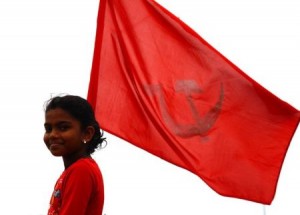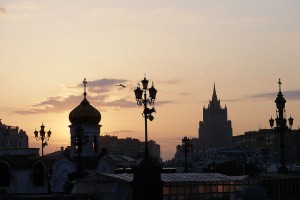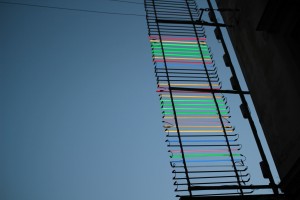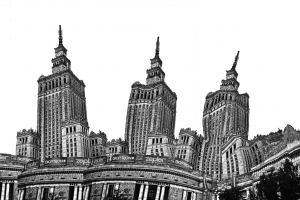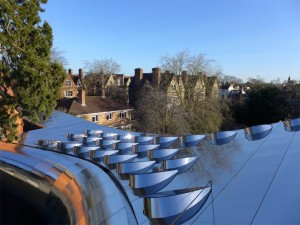Painting your way to freedom
by Albert Genower | May 7, 2024

Painted buildings near Allias, Tirana
Think about communist architecture. What comes to mind? An actual architect would probably see it as too simplistic a term, but whatever you think of, it probably isn’t ‘vibrant’. Shades of grey, beige, and bone were granted a near-monopoly of Eastern Bloc buildings between the end of the Second World War and the fall of communism. Russian-style khrushchevka and brezhnevka dominated the period—those low-cost, flatly-coloured Soviet apartment blocks that stretch out in endless rows across Southern and Eastern Europe’s landscapes. Albania was unexceptional in this regard. By the time communism fell in Albania, these buildings were not only dominant in the country, but themselves were falling into disrepair. But in the early 2000s, a unique campaign to bring more colour to the country’s capital city, Tirana, created remarkable change, saturating the city with a new brightness.

Unpainted communist-era façade in Gjirokastra, Albania. (Courtesy of Wikimedia Commons)
Albania had a rough go of it in the 20th century. After centuries of rule by the Ottoman Empire, the nation emerged independent after the First and Second Balkan Wars in 1912 and 1913. Eventually the country came under the rule of the dictatorial King Zog, who curbed civil liberties, before being occupied by Fascist Italy, and then the Nazis. After World War II, the most oppressive period came: the country was under the thumb of Enver Hoxha, a hardline Stalinist dictator so uncompromising that he fell out with China and Russia over not being strict enough. Albania was transformed into a nation akin to North Korea today: a hermit kingdom paranoid that the rest of the world was out to get them.
Hoxha died in 1985, and six years later his statue in the capital’s Skanderbeg Square would be toppled as part of the fall of European communism. After a rocky start to freedom in the 1990s, Albania began to stabilise as the 21st century approached, adopting its current constitution in 1998. By the time that Edi Rama came to power in Tirana in 2000, Albania was finally in a place to look to the future and decide what their freedom was to look like in the longer term. To Rama, that future was to be colourful. In a massive campaign to bring more joy to life, fresh coats of paint were liberally applied to buildings across the city: pinks, greens, turquoises, oranges—the city became a mosaic of wildly different and shimmering hues.
Tirana’s explosion of colour did not just come in the form of solid blocks of paint. Junction boxes are all adorned with murals, thousands of trees and bushes were planted throughout the city, and traffic lights do not just shine green, amber, and red from their tops, but the whole poles light up in what one travel blog aptly termed “post-revolution technicolour”. The paint is even used to make more direct political points: the kerb outside the Russian embassy is striped in Ukranian yellow and blue on a street newly renamed Free Ukraine Street.
The vibrancy of Tirana is not just restricted to the centre. It’s easy to sling a few coats of paint on government buildings and around the aforementioned Skanderbeg Square, but the painting campaign has extended to the city’s suburbs. At the foothills of the Dajti, the large mountain looming over Tirana’s eastern skyline, there is a museum and a cable car, both proving popular with tourists. Though the large State Road, as it went, was clearly less well-maintained and less accustomed to tourists than the central parts, the brilliant colours did not cease. A colossal studio owned by Televizioni Klan radiated deep, royal blue and crimson across the landscape; a small structure shared by a greengrocers, internet cafe, and Middle Eastern restaurant was coated in olive green. Across the street was a sky-blue block of flats adorned with lemon yellow balconies. Somewhat crudely built into that was another similar building but coated in peach with salmon pink balconies.

Painted buildings near Allias, Tirana
It can seem a bit kitsch, a bit Balamory, and to some extent it is, but it’s a lot better than the alternative and it undeniably gives the city a sense of renewal and dynamism. Rama initiated the campaign because he is a painter—I can’t say I think much of the painting he applied to canvas himself—and called his position as mayor of Tirana the “highest form of conceptual art”. He credited his campaign with making material change, a la the broken windows theory, reducing littering and (allegedly) tax avoidance: “beauty was acting as the guardsman where municipal police or the state itself were missing”.
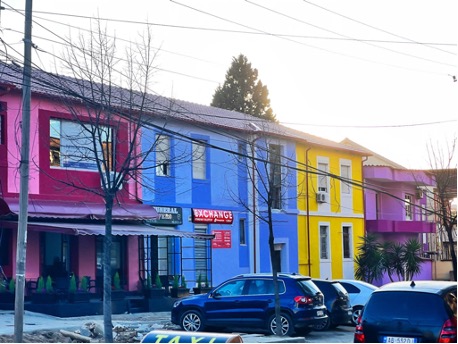
Painted buildings near Allias, Tirana
At the same time, he was saying this as a then-ascending career politician and so waving the flag for one of his mayoral projects is hardly unexpected and so should be taken sceptically. This isn’t a puff piece for Edi Rama, who has now risen the ranks of Albanian politics all the way to prime minister, or really a political piece at all (regarding Albanian politics). I won’t claim to know anywhere near enough about internal Albanian politics to comment on him as a leader of the country. From those I met in Tirana and Durrës, roughly as many love him as hate him, something reflected in approval ratings. Most of his claims about the painting fixing substantial problems came only a year before his landslide election to the premiership of the country, and therefore remain somewhat dubious.
Many Albanians, quite rightly, point out that all this colour is a literal façade: a shiny coat of paint that does little to address more tangible problems. Splashing greens, yellows, and purples across otherwise grey walls doesn’t fix organised crime, corruption, economic hardships, pollution, or outdated infrastructure. Of course, this is true, and it’s a fair criticism to level at the campaign. Albania’s score on the Corruption Perceptions Index sits equal to that of dictatorial Belarus, it’s haemorrhaging its young population at a rate comparable to war torn nations, and it’s one of Europe’s poorest countries. A painting campaign can never fix genuine structural problems—it’s no use fixing the outside of a building if the foundations are crumbling.

Painted buildings in Blloku, Tirana
But it’s not a matter of either/or. The painting makes a significant aesthetic difference to the city; not only did it revivify the city’s drab colour palette, it signified a move into a new era of Albanian history and gives Tirana one of the most unique looks I’ve ever seen a city have. The painting campaign spurred on broader urban renewal projects by Rama’s successors on both sides of Albania’s political spectrum—Edi Rama doesn’t deny that it’s a surface: “the paint on the walls did not feed children, nor did it tend the sick, or educate the ignorant, but it gave hope and light”. Hope and light. The light and hope of the buildings hits the eyes of Tirana’s residents, reflecting an equally radiant brilliance back out. It gives the city a pulsating energy, and in the depths of night the buildings seem to glow.∎
Words by Albert Genower. Photo of Gjirokastra courtesy of Wikimedia Commons, all other photos by Albert Genower.
